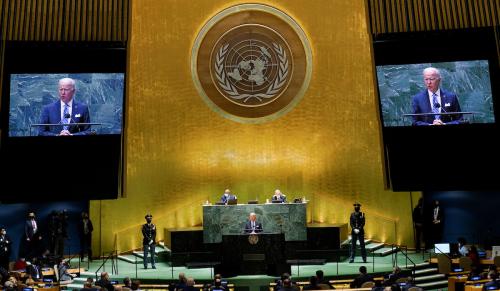On September 18, the Hutchins Center on Fiscal and Monetary Policy at Brookings hosted a discussion on behavioral economics, a field at the intersection of economics and psychology that tries to understand how people make and act on decisions. Maya Shankar, a Senior Advisor for the Social and Behavioral Sciences in the Office of Science and Technology Policy at the White House, spoke of the Obama Administration’s proactive efforts to codify behavioral insights in the administration of public programs. Two examples, culled from a comprehensive report released by the Social and Behavioral Science Team (SBST) last month, demonstrate the power of the nudge to improve the effectiveness and efficiency of government programming.
Promoting retirement security
The Social and Behavioral Science Team partnered with the Pentagon to increase service-member participation in the Thrift Savings Plan (TSP), a retirement contribution program run by the U.S. government. Behavioral science research demonstrates that even small barriers to program engagement—such as unduly complicated information and poorly presented choices—hampers participation. Recognizing that timely, targeted messaging could increase enrollment, SBST launched an e-mail campaign that carefully laid out the application process and framed the decision to enroll as a “yes” or “no” option. The messages that incorporated behavioral insights proved remarkably effective: compared to no message, the most effective e-mail nearly doubled the rate at which service-members enrolled in TSP, leading to roughly 4,930 new enrollments and $1.3 million in additional savings after just the first month.
The SBST-Pentagon partnership took an additional step to use behavioral economics to spur service members’ workplace savings. Research indicates that prompting individuals to make a decision about whether or not to take action at a relevant point in time affects participation, so SBST implemented a project that prompted service members with a “yes” or “no” choice about whether to enroll upon their arrival at a new military base. Controlling for differences across comparison bases and time period, the timely, prompted-choice intervention spurred a 4.3 percentage point participation. Based on the success of this pilot program, the Pentagon has committed to applying behavioral insights to bases and installation with higher troop concentration.
Improving college access and affordability
Every year, 20 to 30 percent of college-accepted high school graduates in urban district do not enroll at university because they fail to complete required pre-matriculation tasks, such as filling out course-enrollment forms, taking placement tests, or completing the FAFSA. Recent research by Benjamin Castelman and Lindsay Page suggests that sending students a text message reminder to complete these tasks might increase enrollment rates. SBST leveraged these findings, and partnered with the Department of Education’s office of Federal Student Aid (FSA) to send personalized text messages to targeted students reminding them of pre-matriculation requirements. The results were striking: this simple and low-cost behavioral nudge spurred a 3.1 percentage point increase in enrollment, a boost from 64.9 percent of to 68 percent of targeted students. The impact of the program was greatest among low-income students, prompting 8.6 percent increase in the number of students to successfully enroll.
Behavioral insights can also be used to help students who have successfully matriculated pay for college. SBST partnered with FSA to develop an e-mail campaign to increase awareness of the income-drive repayment (IDR) plan, a federal program that links borrower’s payments to their monthly income. SBST incorporated behavioral insights about the best way to communicate complex information in an e-mail campaign, launching an e-mail campaign that clearly outlined IDR eligibility criteria, identified the benefits of participation, and the laid our consequences of inaction. Sending these timely, informational e-mails led to a four-fold increase in IDR applications among struggling student loan borrowers. Based on this the success of this program, FSA plans to expand efforts nudge participation in loan repayment programs to borrowers in default and borrowers at risk of withdrawing from school.
The Brookings event and associate report emphasize the SBST projects are designed to address only the behavioral elements that affect how people engage with, participate, and respond to policies and programs. This means that project effects can be modest, but since changes come at little or no additional cost to taxpayers—it is no more expensive to send an effective version of an e-mail than an ineffective one—returns on investment are large. In an era of waning public confidence in the U.S. government and a need among agencies to do more with shrinking appropriations, there is no better time to apply the insights of behavioral economics to public administration and public policy.



Commentary
A nudge toward better governance
October 6, 2015